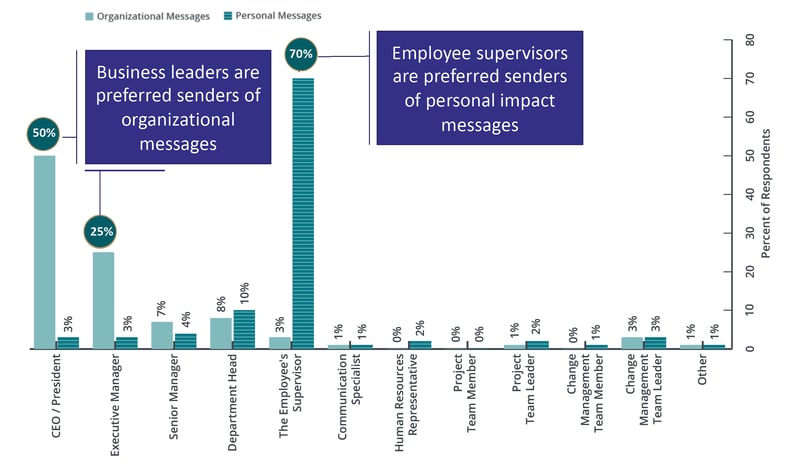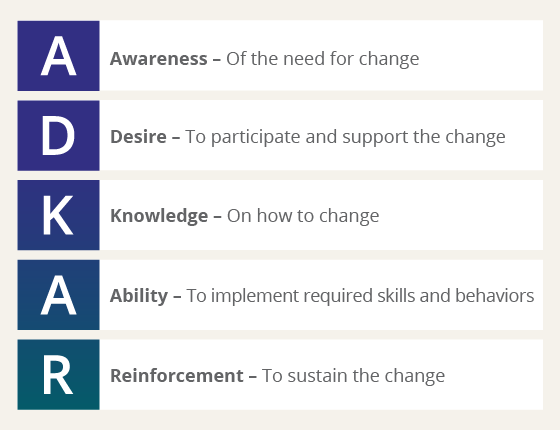3 Roles of a Change-Competent Executive

3 Mins
Updated: September 13, 2022
Published: July 14, 2015

Executives and senior managers play a critical role in the outcome of a change. In Prosci's Best Practices in Change Management studies, executive sponsorship is repeatedly cited as the greatest contributor to project success. In today's competitive marketplace, executives must create a culture and environment where change is seen as "business as usual." A change-competent organization needs a value system and culture that embraces change. And the executive plays a key role in creating this environment.
Executives in a change-competent organization constantly search for ways to improve profitability and growth by reacting to marketplace changes and opportunities, and ensuring that business changes are implemented and realized to their full potential through effective leadership and change sponsorship. This includes active and visible participation in change projects throughout the life of the project.
Change practitioners enable sponsors to fulfill their key roles during change.
Learn how to enlist, engage and empower your sponsors in this free on-demand webinar.
Change-Competent Executives
Executives in change-competent organizations share several characteristics that make them and their organizations successful in the face of change. To achieve change competency, executives need to exhibit traits of a searcher, advocate and provider.
The Searcher
Organizations that embrace change have executives who are catalysts for change. Although changes can bubble up from the bottom, the reality is that most changes today are driven from the top down. Economic conditions, competitor positioning, and shifts in the marketplace result in external pressures to change. Executives must always be looking for ways to improve the financial performance and strategic orientation of the organization. Executives must constantly search for and create opportunities for change to remain viable and successful, and to keep ahead of the competition.
The Provider
Executives must provide adequate resources for change efforts. This provider role includes investment funding as well as human resources and expertise. Resources need to be provided not only to support specific changes, but also to develop the expectation and competencies for change as the norm within the organization.
Special project teams should be composed of capable and dedicated individuals. These members should be well-respected within the organization and have an understanding of the business goals and strategies. They should be articulate, creative and committed. This caliber of resource assigned to special projects often deprives the day-to-day operations of some of the best managers and employees, and therefore requires executive involvement to support these personnel decisions.
Funding and budget are often a major point of contention. Many executives appreciate the cost of system design, testing and validation, but fail to consider the cost of managing the people side of change. Executives can illustrate the importance of change management efforts by providing adequate funds and budget for change management. This investment also begins to support the shift in culture required for change competency by demonstrating the commitment of the organization's leadership.
The Advocate
Executives should be an advocate and sponsor of the change in both professional and personal settings. Prosci research has revealed that the most effective sender of messages related to the business or strategic needs for change are senior executives (interestingly, employees want to hear messages about how the change impacts their daily duties from their immediate supervisors). However, employees prefer to hear the "big picture" message directly from senior executives. Executives play a key role in communicating messages about the reason for change and the vision of the organization after the change.
 Source: Prosci's Best Practices in Change Management – 11th Edition
Source: Prosci's Best Practices in Change Management – 11th Edition
Executives also play an important role in building support within their peer group. Some changes are met by extreme resistance from leaders that are not directly involved in the implementation of the change, but who will ultimately be impacted by some part of it. Executives are responsible for ensuring that senior leaders understand what it means to support change, and that opportunities are provided for training and education of senior management.
The biggest mistake that leaders make is to shift priorities too soon. With the constantly changing pressures on executives, it is easy to change focus and unintentionally abandon the visible and active support of a change underway. The result is often discouraged employees and project teams and ultimately failure to achieve the desired business outcomes of the change. Unfortunately, these failures are often accompanied by lost resources and time, as well as missed opportunities. Maintaining support for change throughout the entire project is critical to building the expectation of change as business as usual.
Finally, executives in the role of advocate must be willing to make the tough decisions when it comes to managing persistent and severe resistance from mid-level managers. In extreme cases, only personnel changes can break through the barriers to change, and executives need to be willing to demonstrate their commitment and leadership through effective personnel management.
Facilitating a Change-Competent Sponsor
 You can use the ADKAR Model to assess and develop your executives into effective change sponsors. The following descriptions list the requirements for building change competency:
You can use the ADKAR Model to assess and develop your executives into effective change sponsors. The following descriptions list the requirements for building change competency:
- Awareness – Executives are aware of the importance of change competency in a competitive marketplace.
- Desire – Executives are committed to building change competency. Executives are willing to make the necessary resource and funding decisions to build change competency into the organization.
- Knowledge – Executives know the steps, behaviors and actions they must take to support change competency. They have been educated on the key success factors and biggest obstacles facing change sponsors. They understand what is required to build a change-competent organization.
- Ability – Executives can dedicate the resources (both financial and human) to building change competency. Executives have demonstrated the ability to support change initiatives on an ongoing basis. Executives have the influence to make change part of "business as usual." Executives can remove barriers and obstacles to change competency.
- Reinforcement – Executives have developed systems for supporting change and for reinforcing change competency in the organization.



